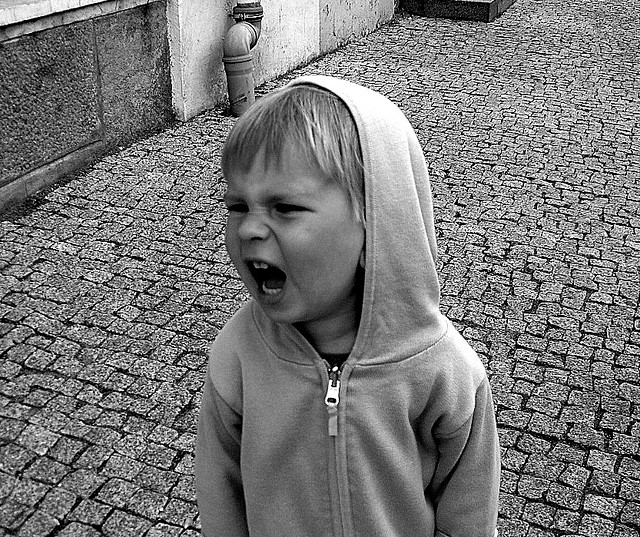
From 7 to 11 years old, children are starting to function on their own in a variety of settings. They are running with friends, completing their classwork, and even doing simple household chores. As a result, adults expect more independence and responsibility from them than ever before. Yet even with their rapidly developing skills, school age kids need warm, supportive, and engaged parents in order to develop sophisticated information processing skills, an independent work ethic, secure emotional attachments, high self esteem, and a strong sense of morality. No longer do parents need to chase school-age kids for physical safety, we now must transition to coaching psychological safety. As you read this crash course, keep in mind how your family’s technology use guidelines may interfere with, or enhance, blossoming developmental skills.
As school age kids become more sophisticated in their cognitive and language skills, adults may be inclined to view them as “little adults.” This is a mistake. Seven to 11 year old kids are still in a stage of rapid development and need active parental supervision and guidance.
Brain Development
These facts provide a sophisticated understanding of anatomical brain development that allow new developmental abilities. Perhaps this will help you keep your perspective as you customize your parenting genius:
- In general, brain development is less like building and more like “remodeling.” It involves both neuronal growth AND demolition. As a result, we often see brain volume increases and decreases in particular areas as children age and reach increasing brain specialization. Just because parts of the brain reach maximal volume does not mean the brain is finished developing.
- For example, as children’s executive functioning becomes increasingly sophisticated (attention, concentration, and organization), frontal lobe gray matter reaches its maximal volume in girls at 11 years old and in boys at 12.1 years old (Lenroot, 2006).
- In regard to brain cell demolition, by the age of 10 some cortical regions begin to show decreases in volume, especially within occipital and superior parietal lobes (Brown, 2012). This is called regulatory pruning and follows the “use it or lose it” principal.
- Brain lateralization means that certain mental processes specialize in either the left or the right hemisphere. This specialization continues to occur during this age, allowing more subtle and coordinated motor activity and complex thought (Lenroot, 2006).
- The efficiency of thinking improves as myelination continues during infancy and throughout adolescence (Brown, 2012). Myelination is the process of sheathing axons (brain cells) with white matter to insulate them and allow them to conduct the electrical impulses that create “thinking.”
- The caudate nucleus is a brain structure found in the area of the brain called the basal ganglia, which plays a role in the control of movement and muscle tone and is involved in circuits mediating higher cognitive functions, attention, and emotional states. The caudate nucleus reaches its largest size at age 7 years old in girls and 10 years old in boys before it declines in volume (Lenroot, 2006).
- White matter and corpus collosum volumes continue to increase as well (Lenroot, 2006). The most prominent white matter structure is the corpus callosum, consisting of approximately 200 million myelinated fibers. The corpus callosum integrates the activities of the left and right cerebral hemispheres, including functions related to the unification of sensory fields (Berlucchi, 1981; Shanks et al., 1975), memory storage and retrieval (Zaidel and Sperry, 1974), attention and arousal (Levy, 1985), and enhancing language and auditory functions (Cook, 1986).
Cognitive & Motor Development
- By now children have lost their first baby tooth and continue increase in size and strength. The average American 7 year old is 50 lbs., 48 inches tall and by 12 years old is 90 lbs., 59 inches tall (CDC.gov). Around ten years old, the onset of puberty begins for many kids, with girls starting slightly ahead of the boys.
- Due to increased size, strength, and coordination, school age kids often become involved in team and individual sports. With these activities, parental roles shift from being caretakers to providers of transportation, coaches, and cheerleaders. These role changes significantly impact family dynamics and can strengthen or strain the parent-child connection.
- Watch out! I’ve found in clinical practice that parents must surrender the fantasy of who they thought their child would become and accept the child they’ve actually got. Engineers learn to embrace their cheerleaders and football coaches support their chess players. The ease of this transition can profoundly impact ongoing attachment. Lucky for us all, by the time children are school age most parents have fallen madly in love and, with this burgeoning new chapter of acceptance, comes a celebration that the real child is preferable to the fantasy child anyway. Accepting the unique qualities of your child may be more challenging for some parents than it is for others. The key is to have fun in your parenting role rather than becoming a drill instructor.

- With increased memory capacity and knowledge stores, children ages 7 to 11 years can now follow instruction without as much supervision. Therefore, they can now spend time and be productive on their own with tasks like chores, homework, and play-dates. Erikson (1964) called this stage industry versus inferiority, meaning that as kids master skills, they develop a sense of pride.
- Watch out! School age, technology native kids can now read and have a working knowledge of technology (often even better than their parents). They are able to seek new activities without adult help and can employ sophisticated work-arounds to parent monitoring, filtering, and blocking efforts. Study up Moms and Dads! With so much to know and changes occurring every day, you need GetKidsInternetSafe (GKIS) support more than ever!
-
- Piaget (1952) considered middle childhood the period of concrete operations, meaning that mental operations (ideas held in memory) can better structure thought process. Now children can think flexibly and solve problems, organize ideas, understand social and moral rules, and interpret people’s intentions.
- Kids this age are also developing metacognitive skills, meaning they gain a more abstract and complex idea of who they are, what they like, and what they want. We also see children’s interests swaying away from parental influence.
-
- Watch out! Pester power becomes more difficult to dissuade as your child’s arguments and strategies get more sophisticated. Internet marketers are experts at developmental psychology and use these concepts to imbed neuromarketing strategies into child screen media activities. As a result, I am seeing kids wearing down their parents to purchase games, apps, and devices that are outside of their appropriate age rating. GKIS was developed to help parents recognize and better manage child screen media choices, despite the pressures of marketers and your unrelentingly pestering kids.
-

Language Development
- As egocentrism wanes, school age children are rapidly gaining metalinguistic awareness: the ability to think about language and to comment on its properties (Cole, 1993). Now kids can adjust the content of their communications to the listeners’ needs with more sophisticated detail.
- Watch out! With these new abilities kids are increasingly able to form complex relationships with adults outside of the family and better able to manipulate caretakers. This is the age that sexual predators often target, because kids are highly vulnerable for Internet grooming. GKIS was developed to help parents block online portals to danger and teach kids resiliency skills so they don’t fall victim. The GKIS Home QuickStart Kit is an excellent tool to be preventative rather than reactive.
Social-Emotional Development
- As they get better at incorporating social comparison, school age kids begin to develop a complex, but relatively stable, sense of self based on increasing cognitive, social, and physical competence (Cole, 1993).
- As school age kids recognize that effort and ability contribute to academic performance, they become more firmly at risk for developing negative academic self-concepts. GKIS’s efforts to support the parent-child connection and best access technological enrichment can help buffer them from this risk.
- Kids within this developmental phase spend increasingly more time with peers than parents, both on- and off-line. Socializing with other children is essential for learning to assertively negotiate conflict. The closer the friend, the more effort your child will put forth to reach a solution (Shaffer, 1989). It is important for parents to provide their children the time and opportunity to develop healthy peer relationships so they can develop social resiliency. The challenge is that kids this age will now choose friends outside of their parents’ influence for personality reasons, rather than simply proximity. As a result, they are exposing, and being exposed to ideas that parents are unaware of and may not approve of.
- Watch out! As a clinician, it is glaringly evident that socialization and guidance during this period is critical to learning the skills necessary for social and partnering success later in life. Based on the problems families bring to my office, I am seeing more and more situations that interfere with unstructured peer group play time like excessive screen time, overload of academic tasks, online relationships that compete with face-to-face friend time, and misguided attempts to protect that instead isolate. These obstacles often cause developmental delay that is difficult, if not impossible, to remedy later. It is more important than ever for parents to spend time with their kids AND their kids’ buddies. Your influence will not only have an impact on your child’s decision-making, but also on the judgment of their friends. Keep a balance between allowing your child social privacy while also staying engaged in the process. GKIS is an excellent forum to discuss “how much is too much?”

-
- Watch out! As kids become more socially competitive, they often experiment with cyber bullying strategies. As more social media platforms pop up, parents have to be more on-the-ball than ever before. Staying plugged in to breaking tech news is a big part of keeping your kids Internet safe.
- Kids move from playing imaginary roles with social scripts to rule-based games. The objective now is not just play to have fun, but play to win. This progression bumps kids directly in the path of conflict negotiation and management of aggression. Girl play is typically more intimate with less direct competition, whereas boy play is in larger groups with more direct competition. Parental encouragement and support of a variety of social activities, including team sports, is awesome for social development.
- School age kids start to segregate by gender during school age, become more interested in gaining popularity, and play often takes on sexual overtones (e.g., kiss tag and teasing). As kids near middle school age and puberty, they may also start being interested in experimenting with intimate partnerships.
- Watch out! Research surveys demonstrate that sexting and posting sexually provocative pictures are common, even among healthy, educated kids and teens. It starts earlier than people think and parents are typically the last to catch on. GKIS will assist you in setting up an honest, transparent system that will help your child avoid scary pitfalls.
- Young children have a difficult time imagining anything outside of their own perspective. Psychologists call this egocentrism. However, during the 7 to 11 year old phase of development, children become less egocentric and are better able to recognize that others have different perspectives, opinions, and intentions than they have. With this new insight, kids can now anticipate how others may react to what they say or do and better “get” potential dangers posed by strangers on the Internet. More specifically, at school age children can imagine that others may have malicious intent and that we all must protect ourselves by not disclosing personal information or unflattering images or actions online.
- Watch out! It’s time to teach your children about the consequences of digital footprints, digital citizenship, and online posting.

- Parents expect more of elementary school children and tend to change their discipline strategies from spanking or time out to withdrawal of privileges and reward.
- Maccoby (1984) described parent-child cooperation in managing behavior “coregulation.”
- This increased self-regulation is consistent with Freud’s (1940) assertion that middle childhood is when the superego (attending to community values and standards) becomes dominant.
- Middle childhood marks the development of conventional morality. Kids this age tend to choose “the right” in order to or do what they think is fair or to fulfill the role of a “good person” (Kohlberg, 1984).
- Piaget (1952) posited that kids ages 5 to 10 years develop a strong respect for rules and enter a stage called heteronomous morality. In this stage kids make decisions based on if there’s a consequence rather than considering the intent of the transgressor. By 10 years old, kids enter the stage of autonomous morality. This means they come to understand that rules can be challenged and even changed if there’s good reason to do so, like intent.
Phew! That’s a lot of developing right there. I tried to keep it short and simple, but that’s difficult due to the massive skill-building that school age kids are developing everyday. Most importantly, it’s critical for parents to recognize that their kids are no longer babies, but not yet adults. They need us now more than ever before!
I’m the mom psychologist who will help you GetYourKidsInternetSafe.
Onward to More Awesome Parenting,
Tracy S. Bennett, Ph.D.
Mom, Clinical Psychologist, CSUCI Adjunct Faculty
GetKidsInternetSafe.com
Photo Credits
Scream and Shout, Mindaugas Danys, CC by 2.0
Playing in MUND West, ubarchives, CC by 2.0
Works Cited
Brown, Timothy T., and Terry L. Jernigan. “Brain Development During the Preschool Years.” Neuropsychology Review 22.4 (2012): 313-33. Web.
CDC, http://www.cdc.gov/nchs/data/series/sr_11/sr11_246.pdf
Christakis, D. A., F. J. Zimmerman, D. L. Digiuseppe, and C. A. Mccarty. “Early Television Exposure and Subsequent Attentional Problems in Children.” Pediatrics 113.4 (2004): 708-13. Web.
Cole, Michael, and Sheila Cole. The Development of Children. New York, NY: Scientific American, 1993. Print.
Erikson, Erik H. Childhood and Society. New York: Norton, 1964. Print.
Freud, S. “An Outline of Psychoanalysis.” The Standard Edition of the Complete Psychological Works of Sigmund Freud. London: Hogarth, 1940. Vol 23. Print.
Hesketh, Kylie D., Trina Hinkley, and Karen J. Campbell. “Children′s Physical Activity and Screen Time: Qualitative Comparison of Views of Parents of Infants and Preschool Children.” International Journal of Behavioral Nutrition and Physical Activity 9.1 (2012): 152. Web.
Kohlberg, Lawrence. The Psychology of Moral Development: The Nature and Validity of Moral Stages. San Francisco: Harper & Row, 1984. Print.
Lenroot, Rhoshel K., and Jay N. Giedd. “Brain Development in Children and Adolescents: Insights from Anatomical Magnetic Resonance Imaging.” Neuroscience & Biobehavioral Reviews 30.6 (2006): 718-29. Web.
Maccoby, E. E. “Middle Childhood in the Context of Family.” Development during Middle Childhood: The Years from Six to Twelve. Washington D.C.: National Academy, 1984. Print.
Perry, David G., Louise C. Perry, Kay Bussey, David English, and Gail Arnold. “Processes of Attribution and Children’s Self-Punishment Following Misbehavior.” Child Development 51.2 (1980): 545-51. Web.Piaget, Jean. The Child’s Conception of Number. London: Routledge & Kegan Paul, 1952. Print.
Piaget, Jean. The Child’s Conception of Number. London: Routledge & Kegan Paul, 1952. Print.
Robinson, T. N. “Reducing Childrens Television Viewing to Prevent Obesity: A Randomized Controlled.” JAMA 282 (1999): 1561-567. Web.
Shaffer, David R. Developmental Psychology: Childhood and Adolescence. 9th ed. Pacific Grove, CA: Brooks/Cole, 1989. Print.
Schmidt, Marie Evans, Jess Haines, Ashley O’brien, Julia Mcdonald, Sarah Price, Bettylou Sherry, and Elsie M. Taveras. “Systematic Review of Effective Strategies for Reducing Screen Time Among Young Children.” Obesity (2012). Web.
Sigman, A. “Time for a View on Screen Time.” Archives of Disease in Childhood 97.11 (2012): 935-42. Web.
Swing, E. L., D. A. Gentile, C. A. Anderson, and D. A. Walsh. “Television and Video Game Exposure and the Development of Attention Problems.” Pediatrics 126.2 (2010): 214-21. Web.
Walker, Lawrence J., Karl H. Hennig, and Tobias Krettenauer. “Parent and Peer Contexts for Children’s Moral Reasoning Development.” Child Development 71.4 (2000): 1033-048. Web.
Don't worry, we will never spam you.










